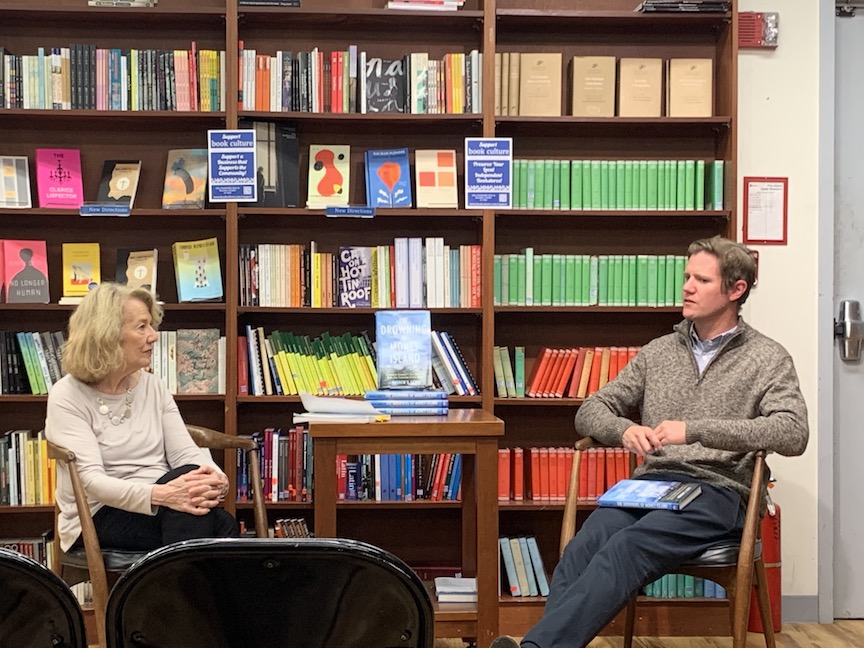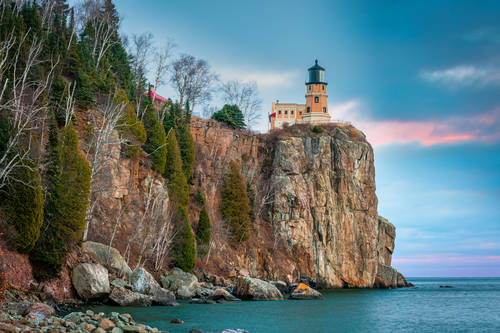Storms pelted New York on Tuesday as Andrew Lewis sat down with Lis Harris at Book Culture on 112th to discuss his debut book, The Drowning of Money Island: A Forgotten Community’s Fight Against the Rising Seas Threatening Coastal America. The weather was appropriate given that his book centers on the aftermath of another storm, Hurricane Sandy, and its effects on the South Jersey Coast.
Specifically, the book focuses on the Bayshore, a 40-mile stretch of marshland and coast along the Delaware Bay. Already a rural and economically depressed area before Sandy, the region has since seen its communities torn apart. This is in part due to the state government’s buyback plan, Blue Acres, which purchases at-risk coastal homes and returns them to nature. In theory, the program is well intentioned. Homeowners can sell their house to the state at pre-storm values, families are able to relocate, and the restored natural wetlands are more resilient to the effects of climate change. These wetlands also provide natural storm protection for the houses that do remain.
In practice, Lewis explained, Blue Acres is another example of how inequality can compound over time. Towns that cannot afford to rebuild are gutted. Unable to bear the cost of repairs, many residents take the buyout. Those that remain in the communities watch as neighbors move away, services decline, and homes are torn down. Towns with the means to rebuild remain intact, and as a result, continue to receive Federal Emergency Management Agency (FEMA) funding and Army Corps support to protect their infrastructure. According to the cold calculations of government math, in these places, there is simply more to lose. These funds are then invested in projects like bulk-heading, beach nourishment, and dune creation, which further stabilizes the shoreline and allows for continual over development in these coastal towns. As a result, an unequal economic distribution occurs.
The historical lack of development on the Bayshore has made the area, relatively speaking, an ecological oasis compared to other parts of the Jersey Coast, but it is also contributing to its demise. As Lewis said in his talk, quoting a New York Times article on the region, “To be unspoiled is to be left behind.”
Lewis grew up on the Bayshore, but in his talk, he revealed that he wanted to approach the subject as an objective observer despite his closeness to the subject. As he spoke, he did so with a journalist’s sense of distance, but underneath it the audience could sense a hometown fervor. His passion and knowledge were apparent in the depth he evoked when speaking about the region. Only someone with a personal stake and intimate knowledge of the region could call forth the images and descriptions he masterfully does.
Lewis’ love for the region was enough to make him return to the region after fifteen years away from it: two in Manhattan and thirteen in California before that. During the talk, he quipped that when people would ask about his heritage, he never understood the question: “I never really traced my roots past South Jersey. In my family there’s a joke; we didn’t come from Europe, we came from marsh mud.”
Ultimately, Lewis’ book is about “the idea of being forgotten” and the divisive politics that idea spawns. It is about a place that, in his mind, is not as sexy in the list of places affected by climate change—not as eye-catching as New York or as glamorous as the Jersey Shore—but still an important piece in understanding the puzzle that is the American political and cultural landscape in the age of climate change.
Most of all, to Andrew Lewis, Bayshore is home: a place of crabs and crabbers, fish and fishermen, where the sun sets over fields of blazing beachgrass, and the people, the ones that do remain, are made of marsh and mud.
Andrew S. Lewis is a contributing writer for Outside and has also written for the New York Times Magazine and Guernica. He received an MFA in nonfiction writing from Columbia University. In 2018 he was awarded a CATWALK Art Residency. He lives in South Jersey, between the ocean and the bay.
David Garczynski grew up on a small barrier island off New York’s coast. He is currently writing a book exploring the region’s lost islands and whether his hometown will join them in the wake of storms and rising seas.




